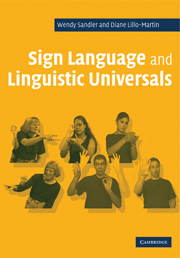Book contents
- Frontmatter
- Contents
- Preface
- Notation conventions
- UNIT I INTRODUCTION
- UNIT II MORPHOLOGY
- UNIT III PHONOLOGY
- UNIT IV SYNTAX
- 17 Syntax: introduction
- 18 Clausal structure
- 19 Clausal structure across sign languages
- 20 Variations and extensions on basic sentence structures
- 21 Pronouns
- 22 Topic and focus
- 23 WH-questions
- 24 Syntax: summary and directions
- UNIT V MODALITY
- References
- Index
24 - Syntax: summary and directions
Published online by Cambridge University Press: 05 June 2012
- Frontmatter
- Contents
- Preface
- Notation conventions
- UNIT I INTRODUCTION
- UNIT II MORPHOLOGY
- UNIT III PHONOLOGY
- UNIT IV SYNTAX
- 17 Syntax: introduction
- 18 Clausal structure
- 19 Clausal structure across sign languages
- 20 Variations and extensions on basic sentence structures
- 21 Pronouns
- 22 Topic and focus
- 23 WH-questions
- 24 Syntax: summary and directions
- UNIT V MODALITY
- References
- Index
Summary
In this unit, we have explored a wide range of phenomena. We have discovered some facts, made some observations, and learned some things about the syntactic structure of sign languages. As in many areas, once we know a bit about something, we have a much greater understanding of what we don't know, and that is certainly the case here. Much more research is needed to make new and more refined generalizations about data, in the service of addressing theoretical questions.
This book focuses on the ways in which sign languages display the universal properties of all languages. Certainly when it comes to syntax, we have seen many similarities between what has been found for sign languages and what is known from the much longer study of spoken languages. But we have argued that studying sign languages contributes more to linguistic theory than studying any other exotic language. This is because where we find similarities across modalities, we can be more certain that we have discovered true universals. Even more important, where we find differences we can begin to understand the contribution of modality to language.
In this chapter we expand on the points just made. We summarize the findings from the chapters on syntax. We outline the need for further research. And we look at the unique position of sign languages for enhanced understanding of the relation between language and modality.
- Type
- Chapter
- Information
- Sign Language and Linguistic Universals , pp. 472 - 474Publisher: Cambridge University PressPrint publication year: 2006



